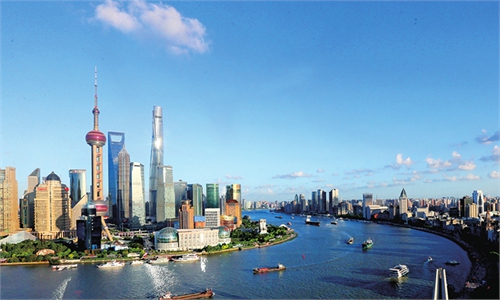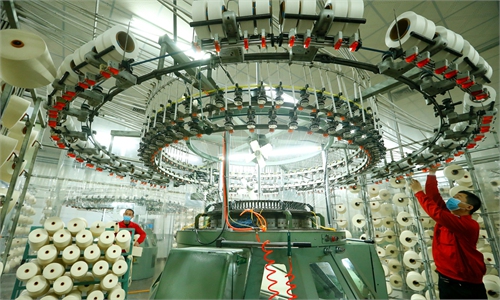China rolls out 33 detailed measures to boost growth; major rebound expected in Q3
State Council’s 33 measures to ensure major rebound in Q3: economist

Shoppers walk through the re-opened Taikoo Li mall in Sanlitun, downtown Beijing on May 29, 2022. Major shopping malls in the city's Chaoyang district announced they had reopened starting from Sunday morning, with anti-epidemic measures in place. Beijing has effectively brought the latest COVID-19 epidemic under control. Photo: IC
China has mounted a full-fledged battle to stabilize its economy, as all levels of governments - from the State Council, the cabinet to ministries to local governments - raced to implement a sweeping set of 33 measures aimed at tackling specific challenges and keep economic operations within in reasonable range, according to an official notice on Tuesday.
The intensifying efforts from Chinese authorities to boost economic growth come as the COVID-19 epidemic situations in Beijing and Shanghai continued to improve, reflecting officials' confidence in keeping the virus under effective control, while shifting focus on economic stabilization - both are crucial deciding factors for the success of the country's dynamic zero-COVID strategy.
The breadth and depth of the measures, the speed and intensity of their implementation, the solid fundamentals of the Chinese economy as well as the effective anti-epidemic efforts will all help ensure economic stability in the second quarter and a major economic rebound in the third quarter, dealing a fresh blow to external forces that have been badmouthing China's zero-COVID policy and its economy, experts noted.
While the measures were revealed by the State Council on Tuesday, they were already issued to all provincial-level governments, ministries and other authorities on May 24, according to a State Council notice on Tuesday.
In the notice, the State Council noted "new challenges" facing the Chinese economy and called on all regions and departments to enhance a sense of "urgency" to implement the measures to stabilize the economy in the second quarter and create a better foundation for the second half.
Reflecting the urgency, the State Council asked all regions and departments to come up with specific implementation plans before the end of May and announced that special inspections would be conducted to check on such efforts. Multiple local governments and ministries have already released their plans to implement the measures and stabilize their local economies.
The 33 administrative measures cover six areas, including fiscal and monetary support, investment, consumption, food and energy security, and supply chain stability. According to the measures, fiscal policy would be accelerated and brought forward, including extending value-added tax refunds to more industries, a move that is expected to increase tax refunds this year to 1.64 trillion yuan ($246.12 billion).
The policy also stipulates that the issuance and use of local government special-purpose bonds should be accelerated and the scope of support should be expanded. One of the policy guidelines suggests the issuance of 3.45 trillion yuan of special-purpose bonds this year.
It is expected the policies and government spending will reach the local level as early as June, and the impact is expected to be reflected in improved economic indicators in the third quarter such as the Purchasing Managers' Index, electricity usage and cargo movements, Cao Heping, an economist at Peking University, told the Global Times on Tuesday, noting that the 33 measures are "detailed" and "feasible."
Cao forecast that China's GDP could grow 3.9 percent on a yearly basis in the second quarter, with a stronger rebound of 5-7 percent expansion in the third quarter. Among the three mainstays of the economy, a fast and solid recovery is expected to first appear in investment, followed by exports and consumption, Cao said.
China Securities estimated that China's economy will touch bottom in the second quarter and accelerate in the second half of the year, with GDP in the second quarter to grow by 2 percent from a year earlier.
As China's economic development is facing headwinds amid domestic COVID-19 flare-ups and a volatile international environment, the government's support measures are expected to strengthen the development of "dual circulation" with a major focus on promoting domestic consumption and investment, Dong Dengxin, director of the Finance and Securities Institute of the Wuhan University of Science and Technology, told the Global Times on Tuesday.
Under the measures to boost consumption, China will also cut taxes on vehicle and home appliances purchases. In terms of infrastructure investment, the policy calls for accelerating investment in transportation infrastructure, including rural road construction and renovation, with a pledge to support the issuance of 300 billion yuan worth of railway construction bonds. Under the policy, 30,000 kilometers of rural roads will be paved, and 3,000 risky bridges along rural roads will be rebuilt.
The measures also cover various supports for small businesses, the platform economy and the private sectors - all crucial part of the Chinese economy. They also include financial and other policy support to accelerate work and production resumption in COVID-hit areas.
"It is estimated a full resumption of work across the country will kick off in June after domestic COVID-19 flare-ups have been gradually brought under control," Tian Yun, a Beijing-based veteran economist, told the Global Times on Tuesday.



